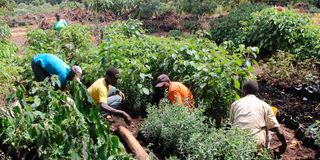Communities restore parts of Mt Kenya damaged by fires

Residents tend to a tree nursery at Kithoka in Imenti forest.
What you need to know:
- Mt Kenya Forest has in the past lost huge chunks of indigenous tree cover to fires that recur every dry season, suppressing natural regeneration.
- A fortnight ago, more than 300 residents who are members of the Ntimaka community forest association (CFA) in Meru County planted 23,000 trees, covering 20 hectares of the degraded sections.
Communities neighbouring Marania section in Mt Kenya have embarked on rehabilitation of 1,600 hectares degraded by perennial fires.
Mt Kenya Forest has in the past lost huge chunks of indigenous tree cover to fires that recur every dry season, suppressing natural regeneration.
A fortnight ago, more than 300 residents who are members of the Ntimaka community forest association (CFA) in Meru County planted 23,000 trees, covering 20 hectares of the degraded sections.
According to Marania forest station manager Phineas Lewa, about one million indigenous tree seedlings are needed to cover the degraded area.
He noted that large parts of the forest are covered in shrubs that are prone to fires.
“If 90 per cent of the seedlings survive after the rains, community members will be allowed in to clear the shrubs and grow crops while tending to the trees. The Forest Plantation guidelines and the Forest Conservation and Management Act require that farmers plant trees first before they are allowed in the forest,” Mr Lewa said.
He added that the community has so far reforested more than 300 hectares of degraded forest land.
Ntimaka CFA Chairman Julius Mugaa said: “Our target is to grow 150,000 trees this year as our members continue to reap benefits from the forest.”
In lower Imenti Forest, residents have cleared more than 600 hectares of invasive species in the forest as efforts to rehabilitate forests in Meru intensify. More than 2,000 hectares of Imenti Forest was covered by the invasive Lantana Camara, commonly known as the Tickberry plant, suppressing growth of trees.
The large swathes of Lantana Camara have been blamed for high cases of human-wildlife conflicts as elephants run out of trees to feed from and hence invade farms.
Speaking recently during a tree planting exercise to mark the International Day of Forests at Kithoka forest station, Meru Forest Environmental conservation and protection community forest association secretary Dorothy Naitore said more than 400,000 seedlings are needed this rainy season.
Ms Naitore said the association intends to rehabilitate 640 hectares of forest by May in efforts to restore tree cover. “We urge the government and other well-wishers to support the community’s efforts by supplying seedlings and other resources needed to rehabilitate the forest. We are also encouraging people to plant high value trees in their farms for additional benefits,” Ms Naitore said.
She said the association has so far planted more than 500,000 trees to rehabilitate the Imenti Forest.
Kithoka forest station manager Bernard Wahome said the involvement of communities in rehabilitating the forest had enhanced environmental conservation.





